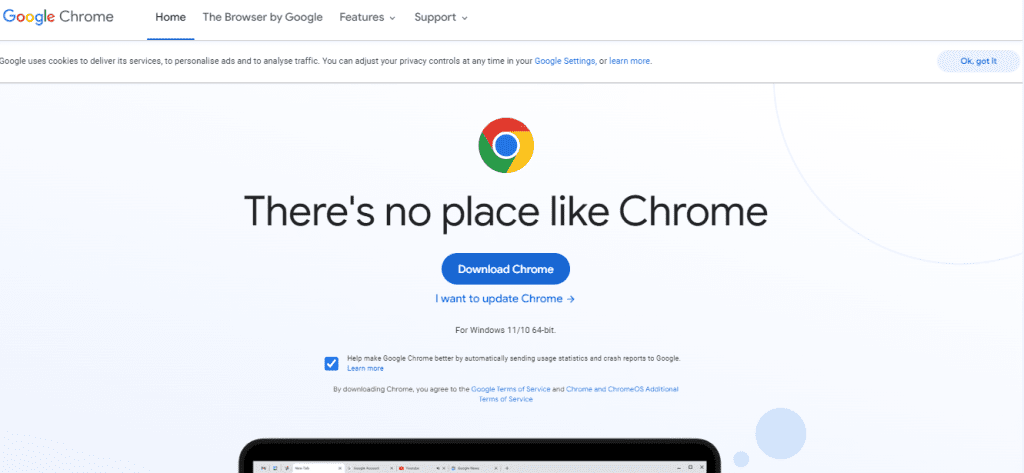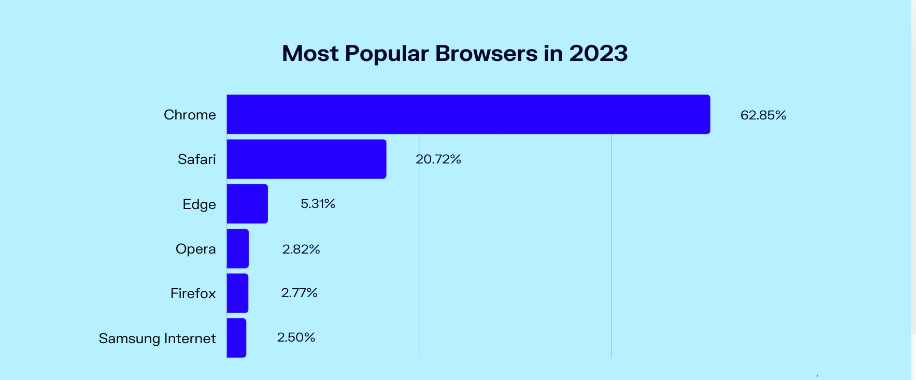Google Chrome is a web browser developed by Google. It is the most popular web browser in the world, with over 65% of the global market share. Chrome is known for its speed, security, and ease of use.
What is Google Chrome Web Browser?
Google Chrome Browser is a free internet browser utilized for getting to the web and running online applications. The Google Chrome web browser depends on the open-source Chromium internet browser project. Google delivered Chrome in 2008 and issues a few updates every year.
Google Chrome is accessible for Microsoft Windows, Apple macOS, and Linux work area working frameworks (OSes), as well as the Android and iOS portable working frameworks. Google Chrome is the default browser for Google gadgets including Android telephones and Chromebook workstations. It is the most utilized internet browser, with 66% of the market as of November 2022, as per StatCounter.
Google Chrome is essential for Google benefits, Google’s group of items that incorporate Gmail, Google Guides, and the Chrome web search tool. A considerable lot of Google administrations are facilitated on Chrome, which was one of the primary web software to utilize the cloud to help applications like Google Docs, Google’s well-known word processor.

Here are some of the features of Google Chrome:
- Speed: Chrome is one of the fastest web browsers available. It uses a variety of techniques to optimize performance, such as pre-fetching resources and using a sandboxed renderer for each tab.
- Security: Chrome is designed with security in mind. It includes features such as sandboxing, which isolates each tab from the others, and phishing protection, which helps to prevent you from visiting malicious websites.
- Ease of use: Chrome is easy to use and navigate. The interface is simple and intuitive, and the browser comes with a variety of built-in features, such as autofill, password manager, and extensions.
To download Google Chrome on your laptop, follow these steps:
- Go to the Google Chrome website.
- Click on the “Download Chrome” button.
- The download will start automatically.
- Once the download is complete, open the .exe file and follow the on-screen instructions to install Chrome.
Once Chrome is installed, you can start browsing the web. To open a website, simply type the address into the address bar and press Enter.
Here are some additional tips for using Google Chrome:
- To customize Chrome, open the settings menu (three dots in the top right corner) and select “Settings”.
- To install extensions, open the Chrome Web Store and search for the extension you want.
- To sync your Chrome settings across devices, sign in to Chrome with your Google account.
Here are some additional things you can do with Google Chrome:
- You can use Chrome to access extensions, which are small programs that can add new features to the browser. There are extensions for everything from blocking ads to translating websites.
- You can also use Chrome to sync your browsing data across devices. This means that your bookmarks, history, and passwords will be saved on all of your devices that are signed in to your Google account.
- Chrome also has a built-in voice search feature. This allows you to search the web or control your computer by speaking into the microphone.
- If you are concerned about your privacy, you can use Chrome’s incognito mode. This mode will prevent Chrome from saving your browsing history, cookies, or other data.
- Browse the web: Chrome can be used to access websites, search for information, and read news.
- Use extensions: Chrome has a large library of extensions that can add new features to the browser. There are extensions for everything from blocking ads to translating websites.
- Sync your data: Chrome can sync your browsing data across devices. This means that your bookmarks, history, and passwords will be saved on all of your devices that are signed into your Google account.
- Use voice search: Chrome has a built-in voice search feature. This allows you to search the web or control your computer by speaking into the microphone.
- Incognito mode: Chrome has an incognito mode that allows you to browse the web without saving your browsing history, cookies, or other data.
If you are looking for a fast, secure, and easy-to-use web browser, then Google Chrome is a great choice. It is available for Windows, macOS, Linux, Android, and iOS.
How to install Chrome on an Android emulator?
There are a few ways to install Chrome on an Android emulator. Here are two methods:
Method 1:
- Download the Chrome APK file from the Chrome website.
- Open the Android emulator and enable the “Install apps from unknown sources” setting.
- Drag and drop the Chrome APK file onto the emulator screen.
- Follow the on-screen instructions to install Chrome.
Method 2:
- Open the Google Play Store on the Android emulator.
- Search for “Chrome” and tap on the Chrome app.
- Tap on the “Install” button to install Chrome.
Once Chrome is installed, you can open it by tapping on the Chrome icon on the emulator home screen.
How to log in to Chrome?
To log in to Chrome, you need to have a Google account. If you don’t have a Google account, you can create one for free.
Once you have a Google account, you can log in to Chrome by following these steps:
- Open Chrome.
- Click on the three dots in the top right corner of the window.
- Select “Settings”.
- Scroll down and click on “Sign in to Chrome”.
- Enter your Google account email address and password.
- Click on “Sign in”.
Once you have logged in to Chrome, your bookmarks, history, and other settings will be synced across all of your devices that are signed in to your Google account.
Here are some of the benefits of logging in to Chrome:
- You can sync your bookmarks, history, and other settings across all of your devices.
- You can access your Google apps and services, such as Gmail, Google Drive, and Google Photos, from Chrome.
- You can get personalized recommendations for websites and content.
- You can protect your privacy by signing in to Chrome with a strong password.
If you are having trouble logging in to Chrome, you can try the following:
- Make sure that you are using the correct Google account email address and password.
- Try restarting Chrome.
- Clear your Chrome browser data.
- Reinstall Chrome.
What is the history of Chrome history?
The History of Chrome History
Google Chrome is one of the most popular web browsers in the world, and it has a long history of tracking its users’ browsing activity. In this blog post, we will take a look at the history of Chrome history, from its beginnings to the present day.

The Early Days of Chrome History
When Chrome was first released in 2008, it did not have a built-in history feature. However, users could install a third-party extension to track their browsing activity. In 2010, Google added a built-in history feature to Chrome. This feature allowed users to view a list of the websites they had visited, as well as the date and time of each visit.
The Evolution of Chrome History
Over the years, Chrome history has evolved to include more features. In 2012, Google added the ability to search through browsing history. In 2013, Google introduced the “Incognito Mode”, which allows users to browse the web without their history being saved. In 2017, Google added the “Clear Browsing Data” feature, which allows users to delete their browsing history, cookies, and other data.
The Future of Chrome History
It is likely that Chrome history will continue to evolve in the future. As more and more people use Chrome, Google will need to find ways to make the history feature more user-friendly and secure. It is also possible that Google will add new features to Chrome history, such as the ability to track browsing activity across different devices.
What are the new features of Chrome 2023?
Google Chrome is constantly being updated with new features and improvements. Here are some of the new features that are expected to be released in Chrome 2023:
- Improved performance: Chrome is already one of the fastest web browsers available, but it is still being optimized for better performance. This includes features such as reducing the number of background processes and improving the way that Chrome uses memory.
- Enhanced security: Chrome is always being updated with new security features to protect users from malware and other threats. This includes features such as improved sandboxing and phishing protection.
- New features for developers: Chrome is also being updated with new features for developers, such as improved debugging tools and support for new web technologies.
- Improved accessibility: Chrome is being made more accessible to people with disabilities, with features such as improved keyboard navigation and support for screen readers.
- New privacy features: Chrome is being updated with new privacy features, such as the ability to delete browsing history more easily and the ability to block third-party cookies.
These are just a few of the new features that are expected to be released in Chrome 2023. Google is constantly working to improve Chrome, so it is likely that there will be even more new features released in the future.
Read also: Google Maps: The Essential Tool for Navigation and Exploration







